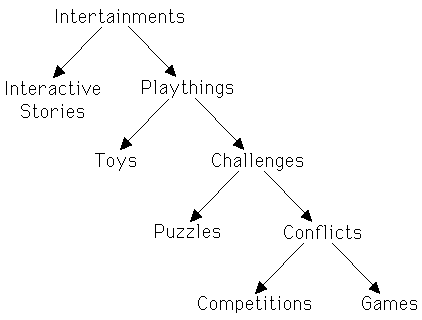Over the last several issues of the Journal, we have had articles discussing definitions of the term "game". These articles mirror a debate that has raged in the JCGD RT on GEnie. Although this article represents my own thoughts on the matter, I am borrowing heavily from ideas first expressed by Dave Walker, Evan Robinson, and other correspondents on GEnie.
"Intertainment" is the class of activities that entertain through their interactive nature. This is the broadest class of activities; for now we recognize two subclasses to this class: interactive stories and playthings.
"Interactive stories" are conventional stories with some small interactive element added. They have a defined storyline through which the user progresses, ultimately reaching a single predefined endstate. The user may meander through different paths in experiencing the story, but the basic direction of motion through the story is unchanged. The solution of puzzles is not the primary intent of the intertainment; the primary entertainment value of the activity lies in the story. Examples of this class are the AmandaStories, Manhole, Cosmic Osmo, and Loom. Earlier examples are the Make Your Own Adventure line of books.
"Playthings" are systems that entertain through their response to the player’s actions. These are systems with defined behaviors established through physical properties, formal rules, or algorithms. The behaviors are entertaining because the player finds them interesting. All members of this class are indulged in through play. There are two subclasses of this class: toys and challenges. The differentiation between the two classes lies in the presence or absence of a defined goal. Note that the presence or absence of such a goal is provided by the player while playing with the plaything. That is, a given plaything can be used by one player as a toy, and later used by another player as a challenge. The distinction arises from the player’s use of the plaything and is not necessarily intrinsic to the plaything.
"Toys" are playthings without defined goals. A player uses a toy in an unstructured fashion, without pursuing an explicit goal. This does not mean that the player’s actions are arbitrary, for the player can still be engaged in exploratory play, determining in some fashion the behavior of the toy. The player’s exploration may indeed follow some exploratory structure, but this structure is not directed towards the satisfaction of any goal other than the determination of the behavior of a system. For example, a child may play with a crawling insect as a toy by attempting to determine the insect’s response to various obstacles that the child places before the insect. The child may follow a methodology of his own devising and still be said to be using the insect as a toy. However, if the child sets himself the goal of confining the insect to a defined region, then the insect is no longer a toy. Examples of software toys are SimCity and SimEarth.
"Challenges" are playthings with clearly defined goals. The player of a challenge seeks to achieve some defined standard of performance. The challenge can take many forms: physical, as in an athletic sport; hand-eye coordination, as in an arcade game; or intellectual, as in chess. There are two subclasses of challenges: puzzles and conflicts, differentiated by the presence or absence of purposeful opponents. A purposeful opponent need not be a human being. It is instead any collection of algorithms that creates an illusion in the mind of the player of a purposeful will seeking to beat the player. This is determined by both the complexity of the algorithms and the perceptiveness of the player. A sufficiently insightful player will perceive the most advanced artificial intelligence to be nothing more than a collection of algorithms to be second-guessed; to such a player, there are no purposeful opponents, only puzzles.
"Puzzles" are challenges with no purposeful opponents. They have a clearly defined goal and a variety of obstacles that the player must overcome to achieve the goal. The obstacles may be active or dynamic, and may even have behavior patterns of their own. However, so long as the player does not attribute to their behavior a purposeful attempt to foil his actions, they are obstacles rather than opponents and the challenge is a puzzle. The majority of entertainment software products are puzzles. Adventures, for example, whether text or graphic, are puzzles. Tetris and its clones are puzzles.
"Conflicts" are challenges with purposeful opponents. There are two subclasses of this class: competitions and games. They are differentiated by the ability of the opponents to impede each other’s performance. If the opponents are constrained from impeding each other and instead devote the bulk of their attentions to maximizing their own performance, then the conflict is a competition. If on the other hand, they are permitted to hurt each other’s performance, then the conflict is a game.
"Competitions" are conflicts without impeding action between the competitors. Examples are races and political campaigns. It is almost always against the rules of a race for the racers to take direct action against each other (tripping, stabbing, mudslinging.)
This leaves games as conflicts in which the players directly interact in such a way as to foil each other’s goals. In other words, if you can shoot back at the other guy, and he shoots at you in a manner that convinces you that he’s out to get you, then it’s a game. Their Finest Hour, Railroad Tycoon, Second Front and Trust & Betrayal are all games.
This can all be summarized with a taxonomic diagram:

